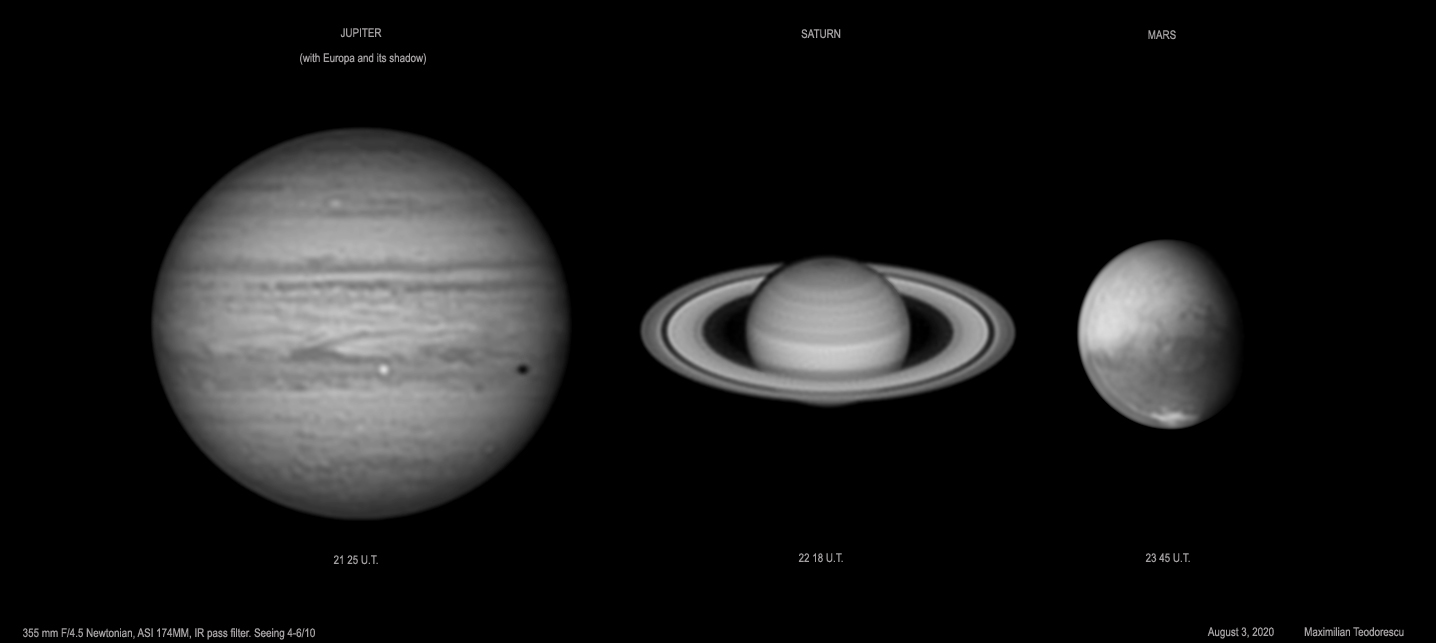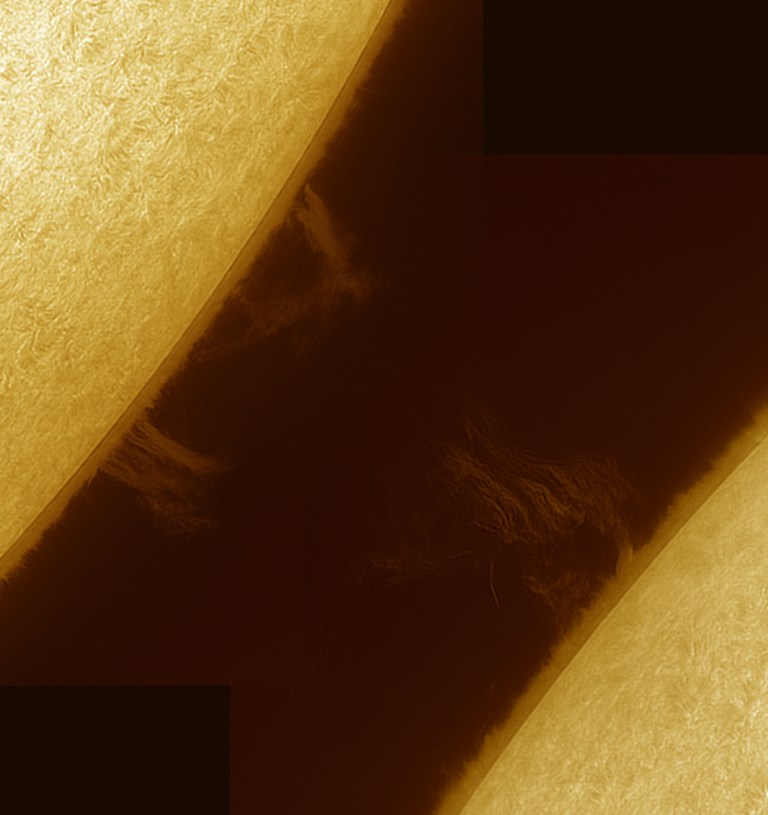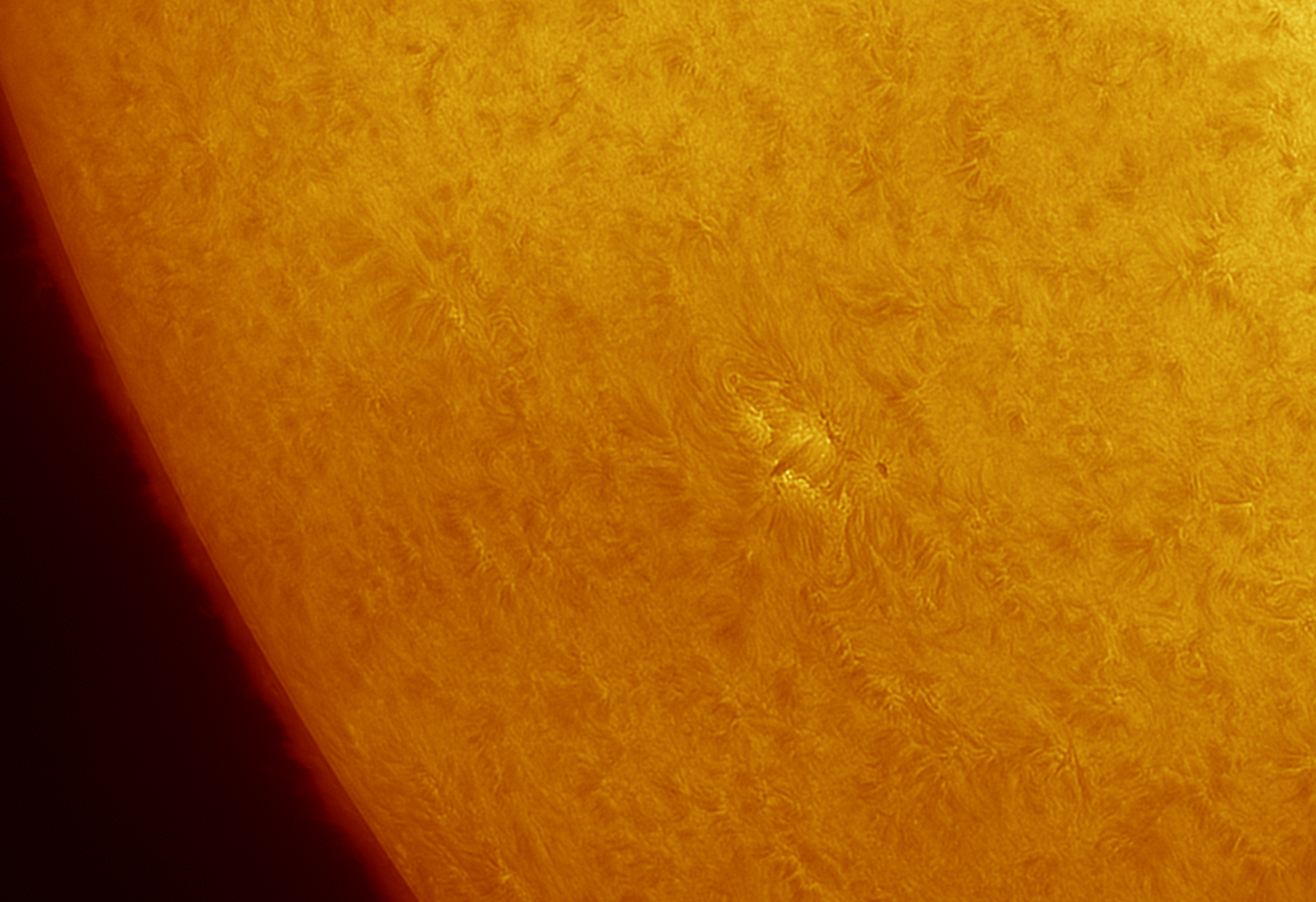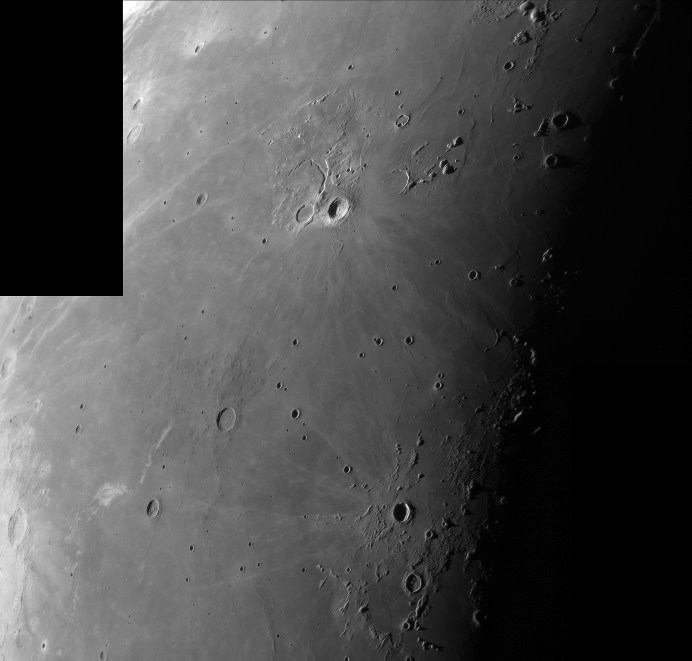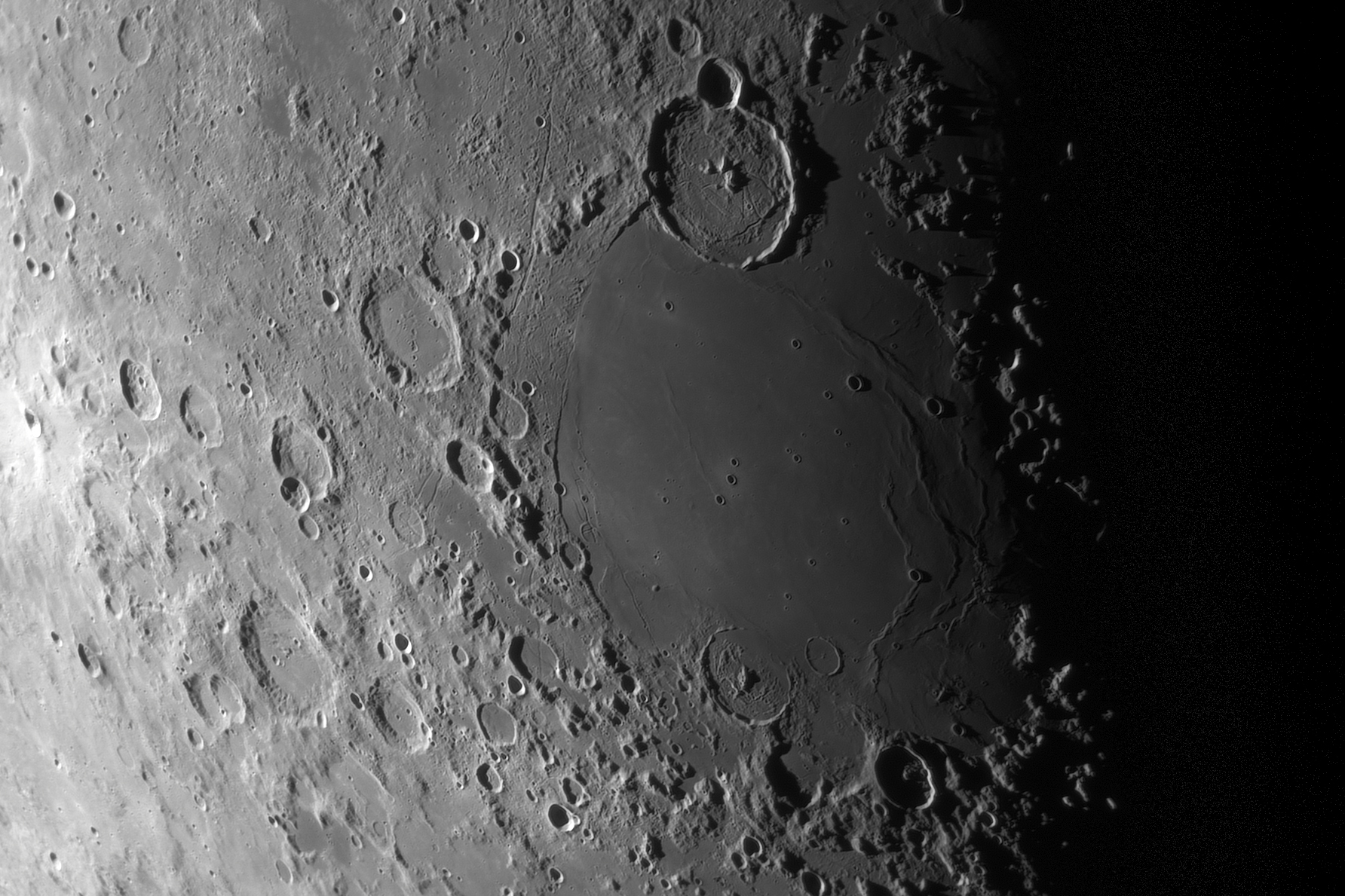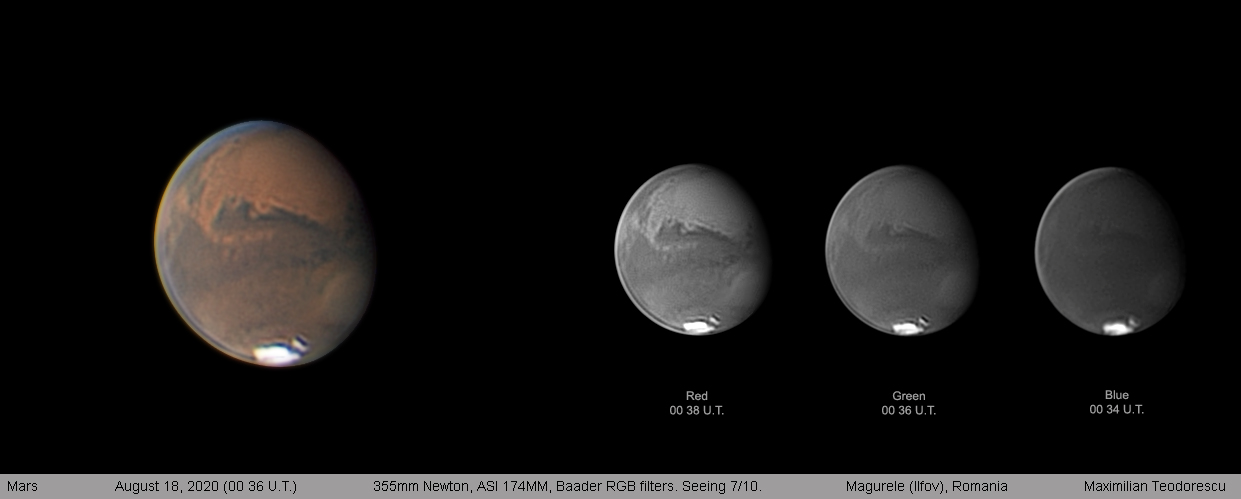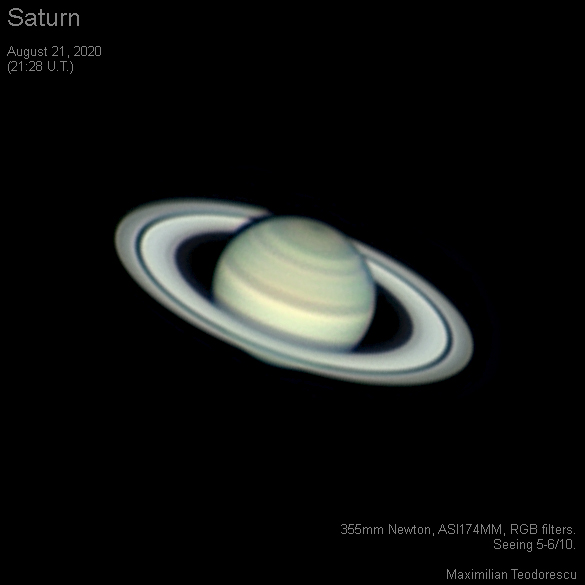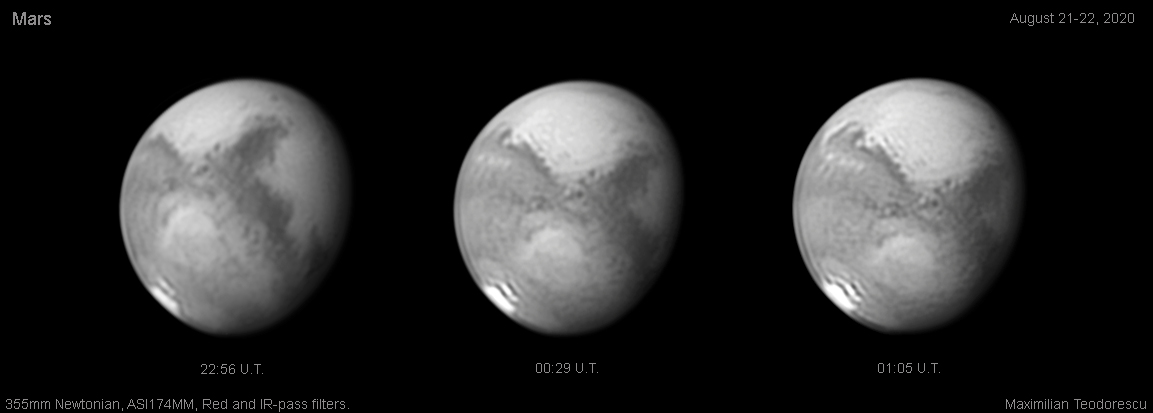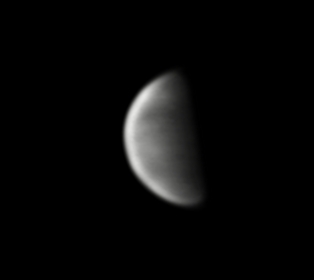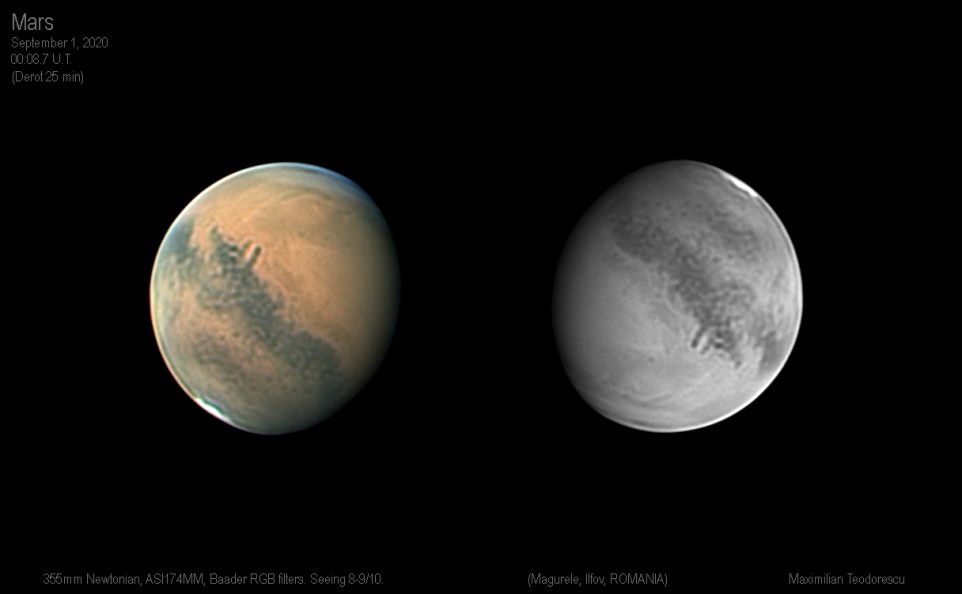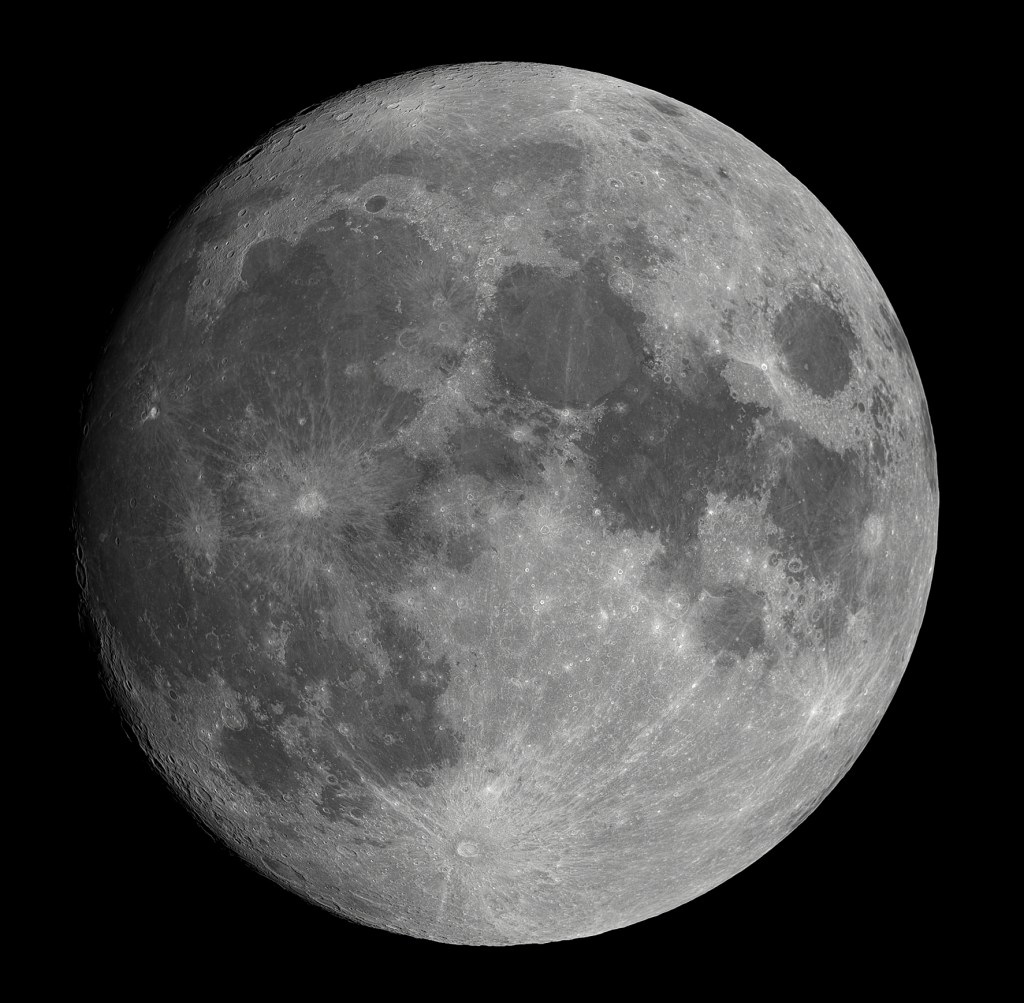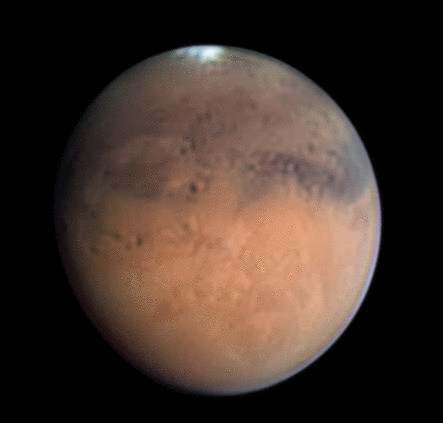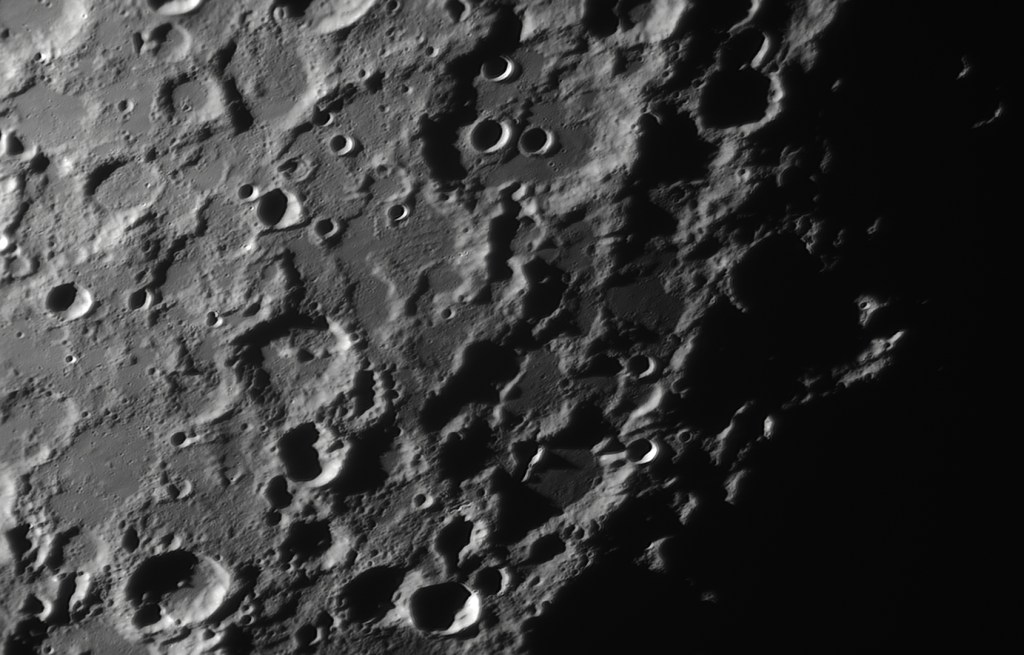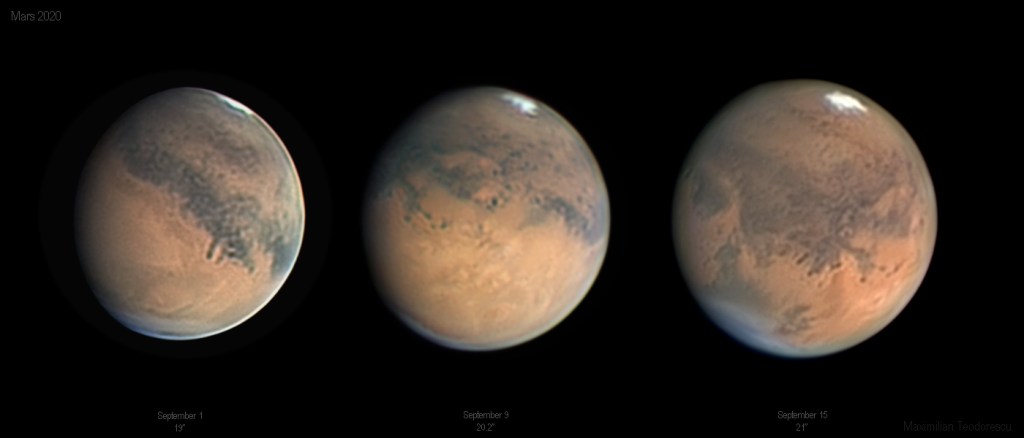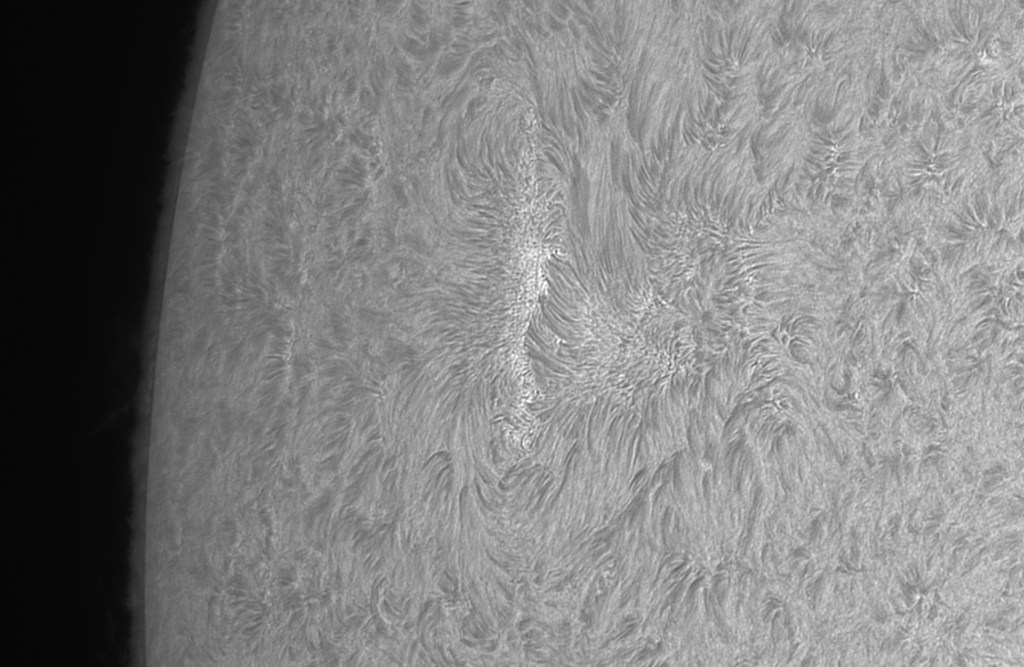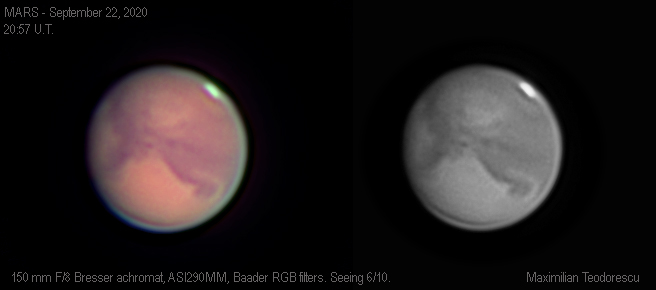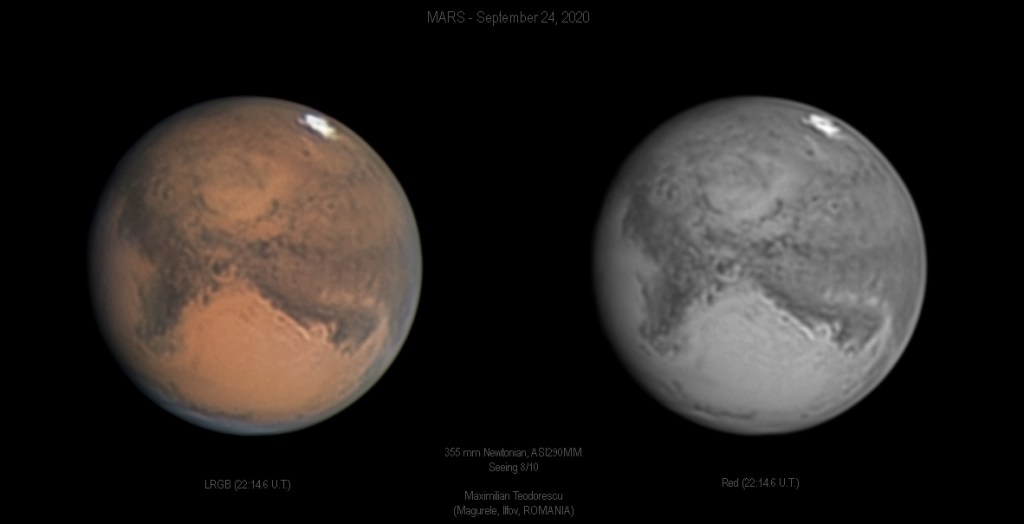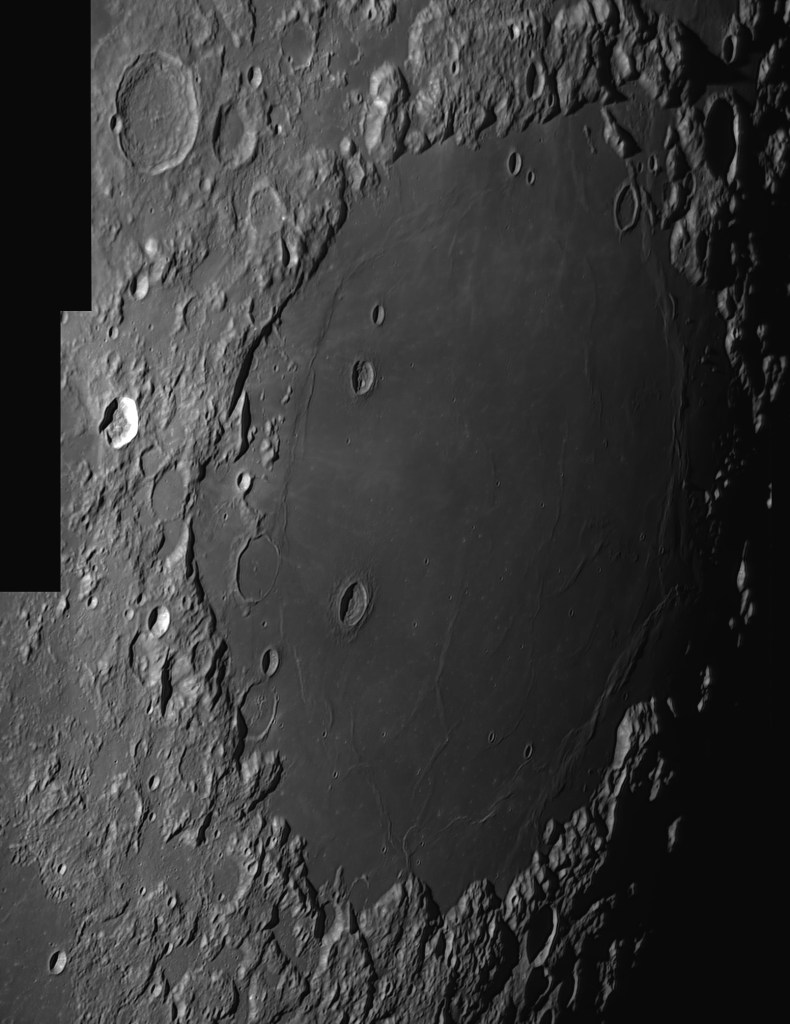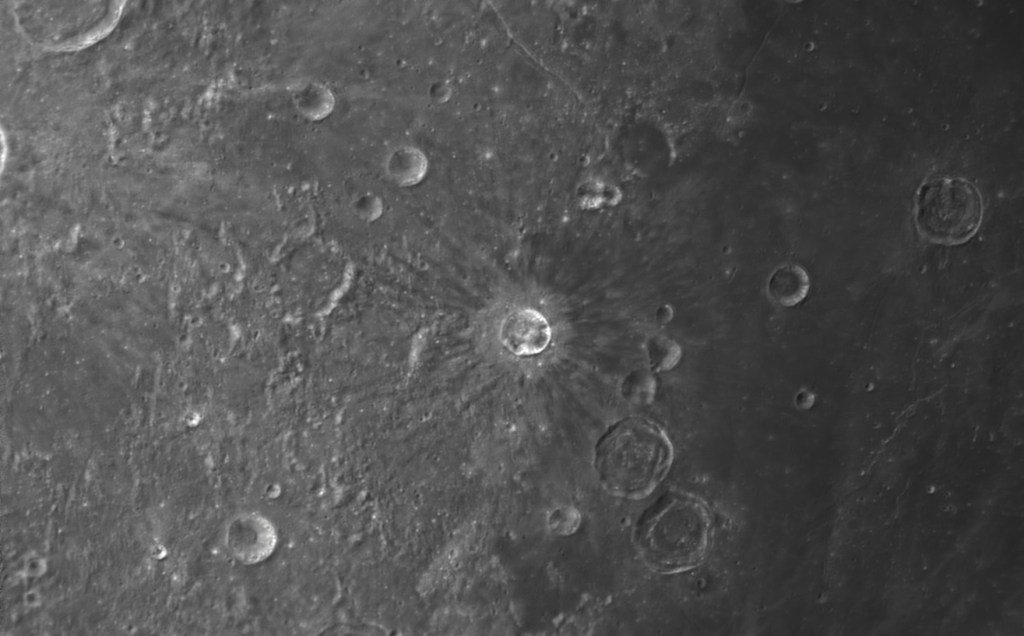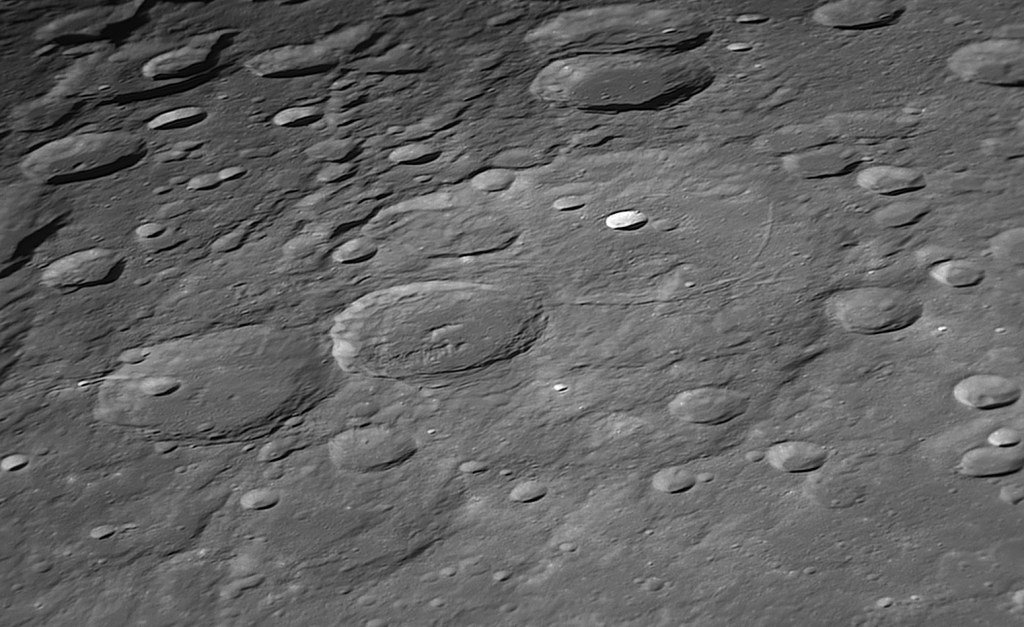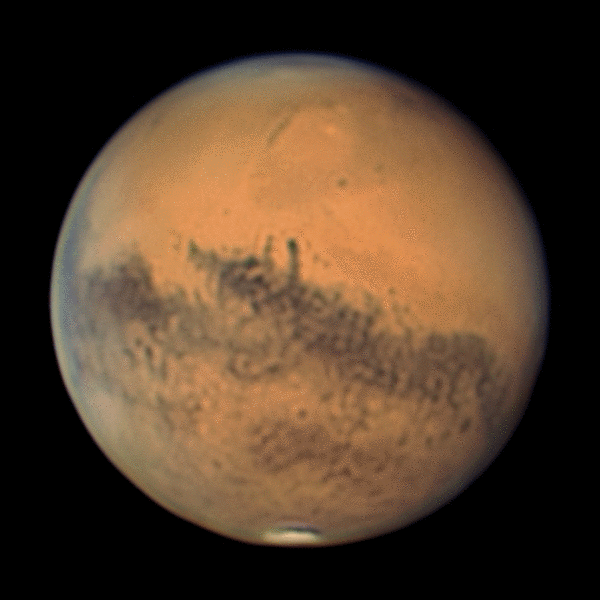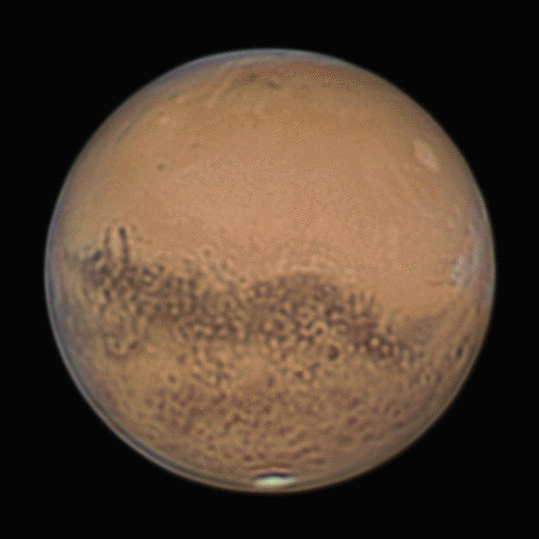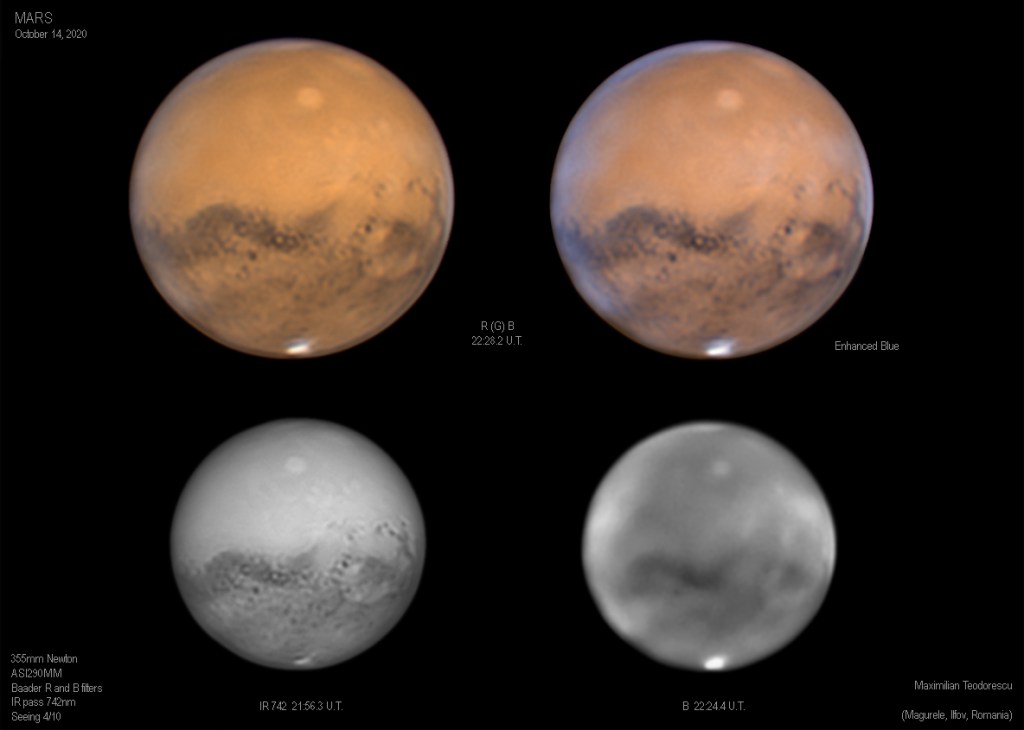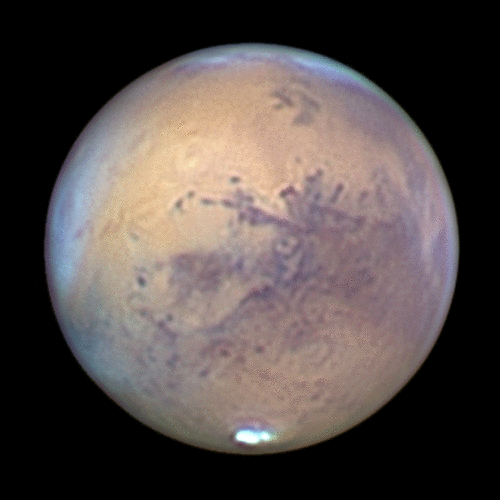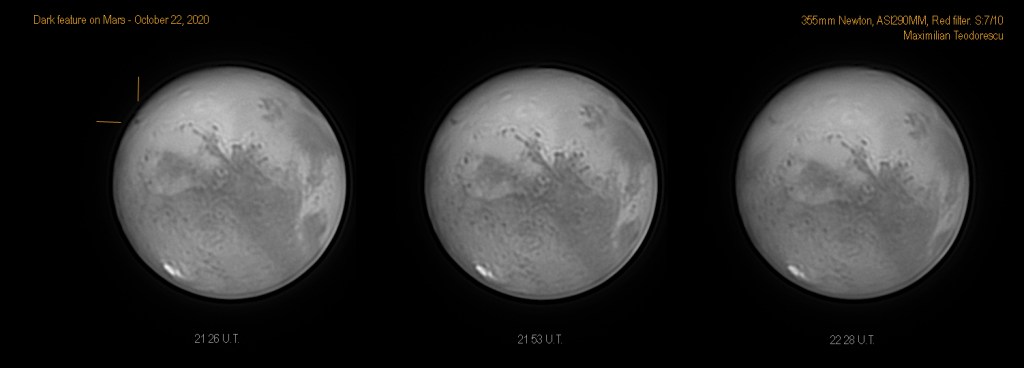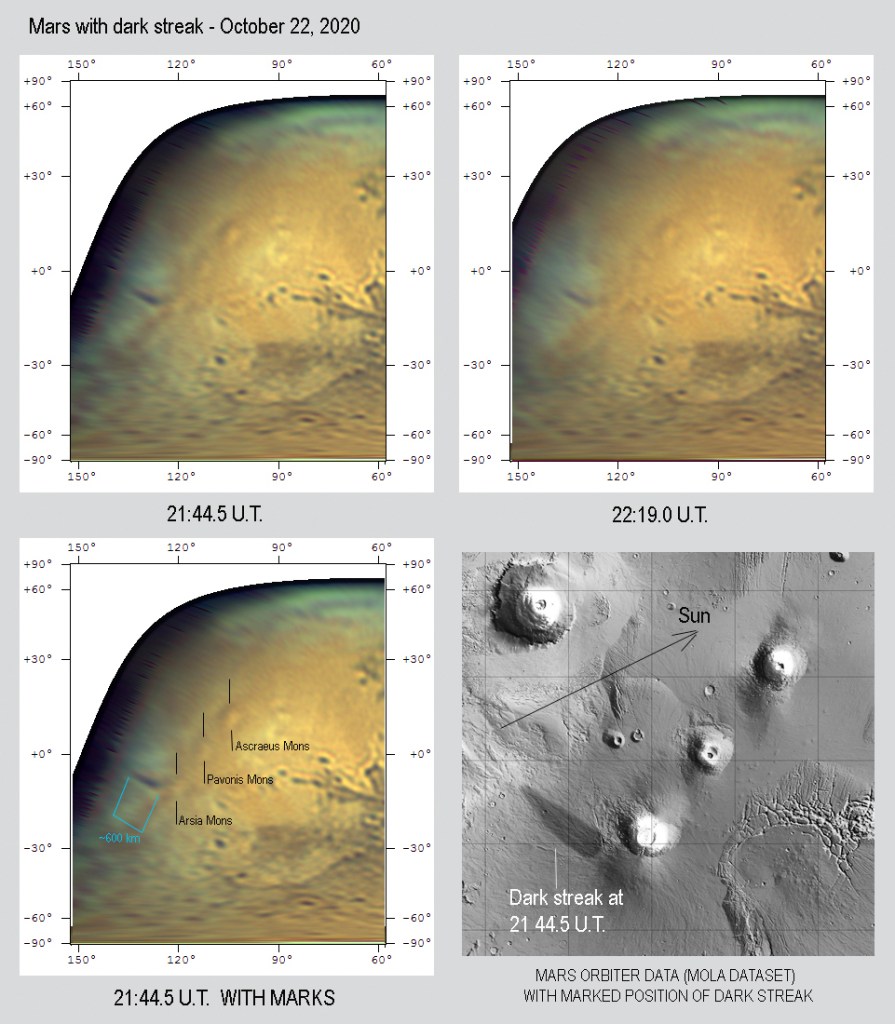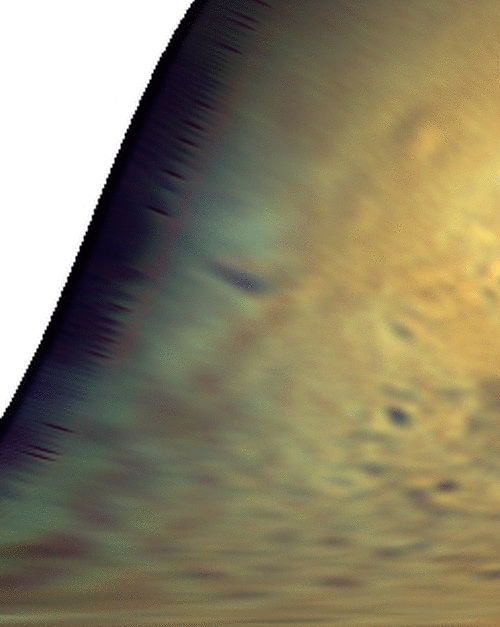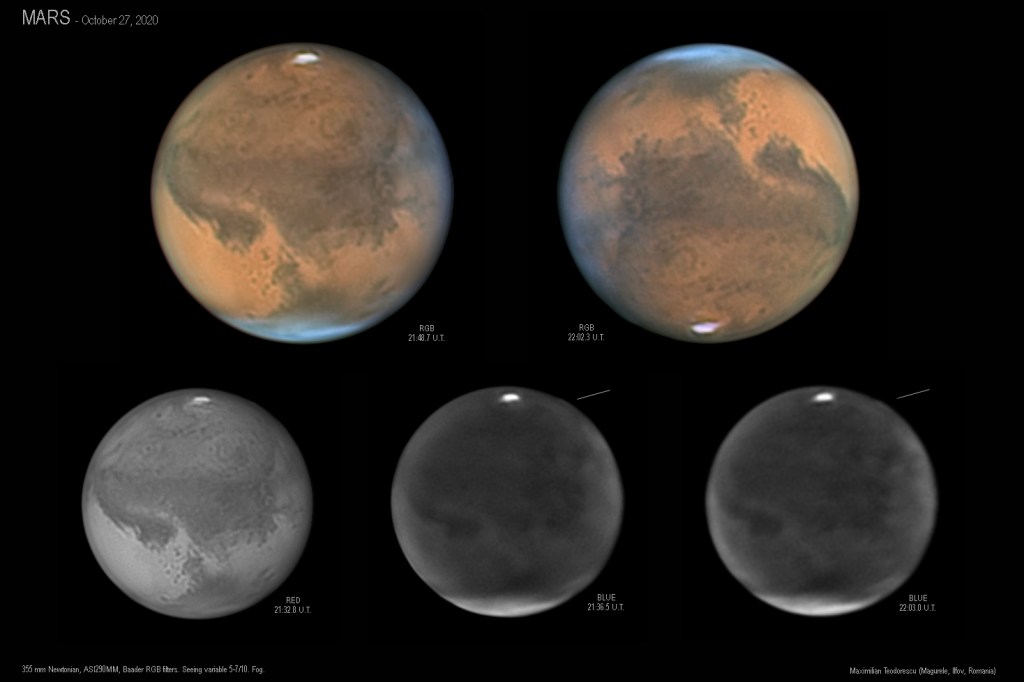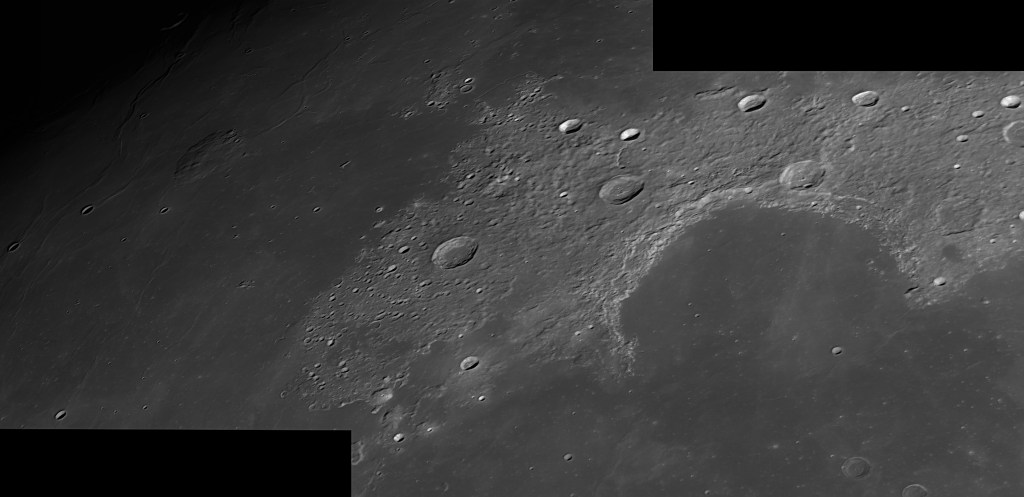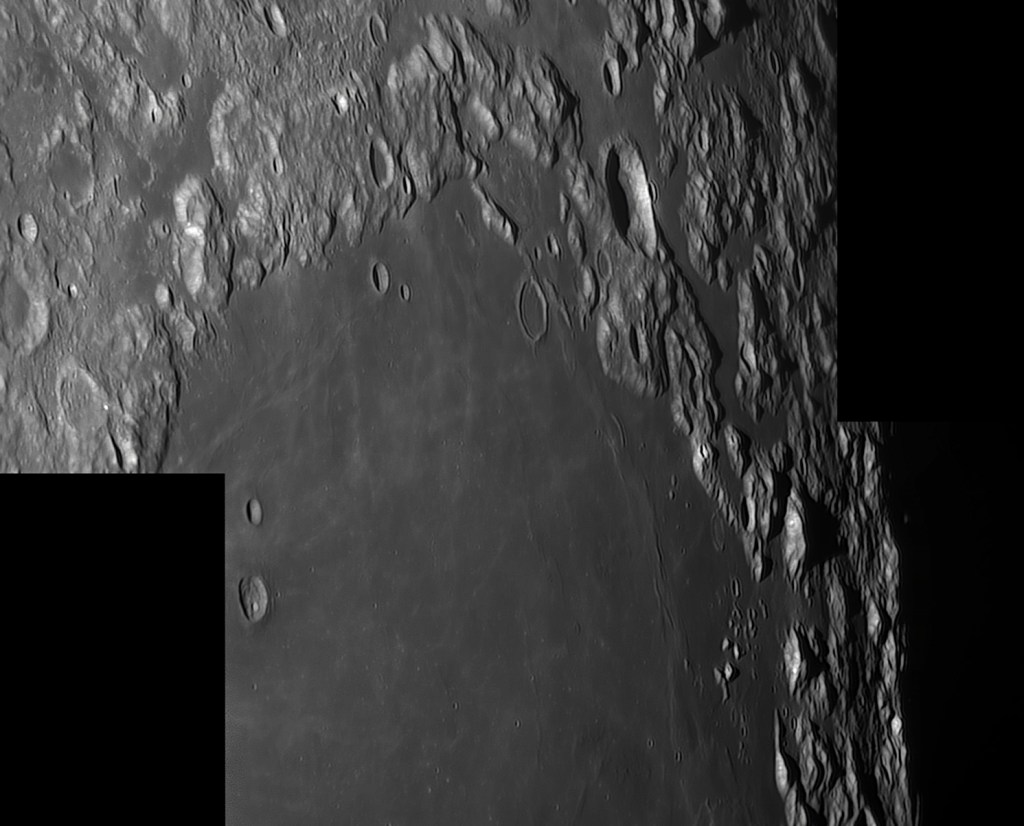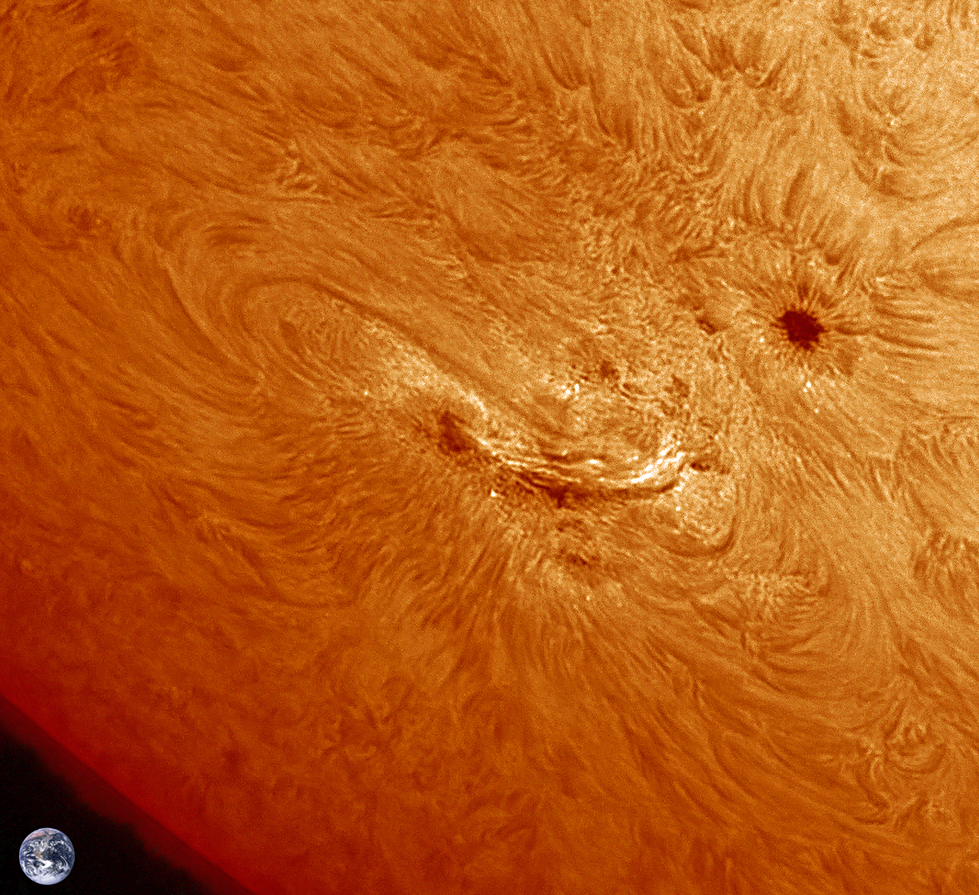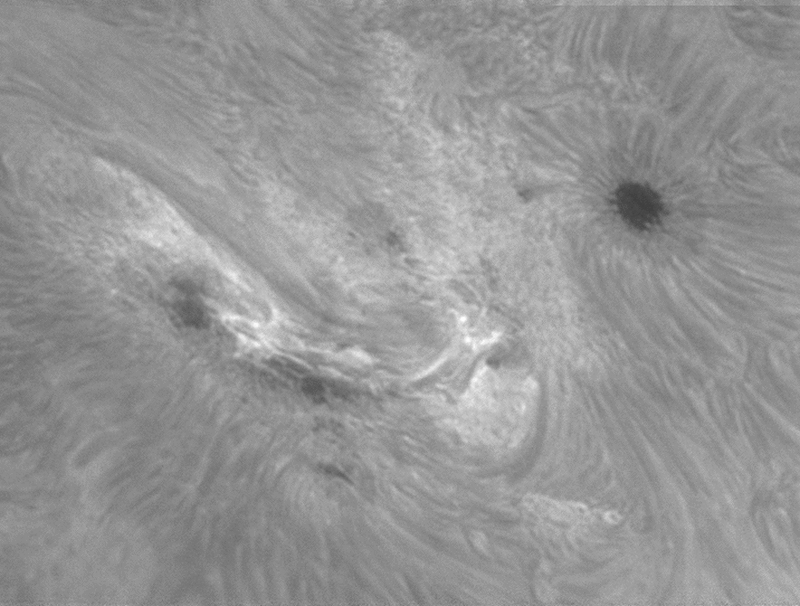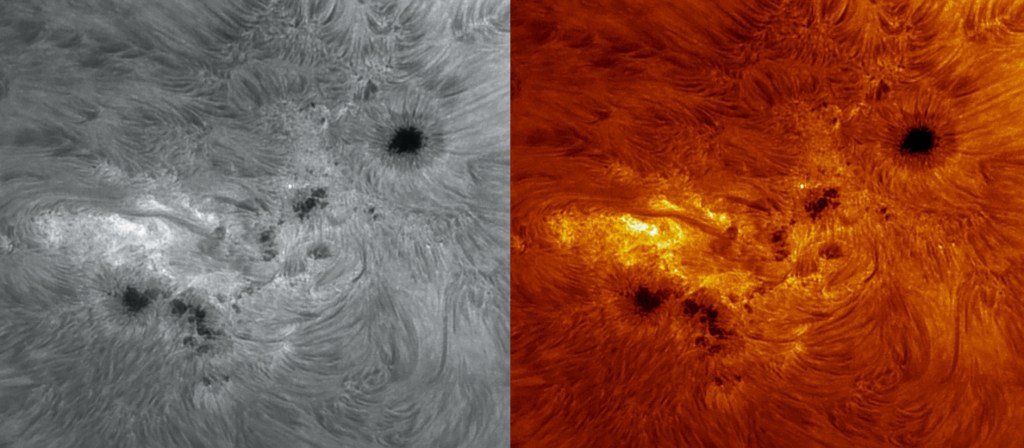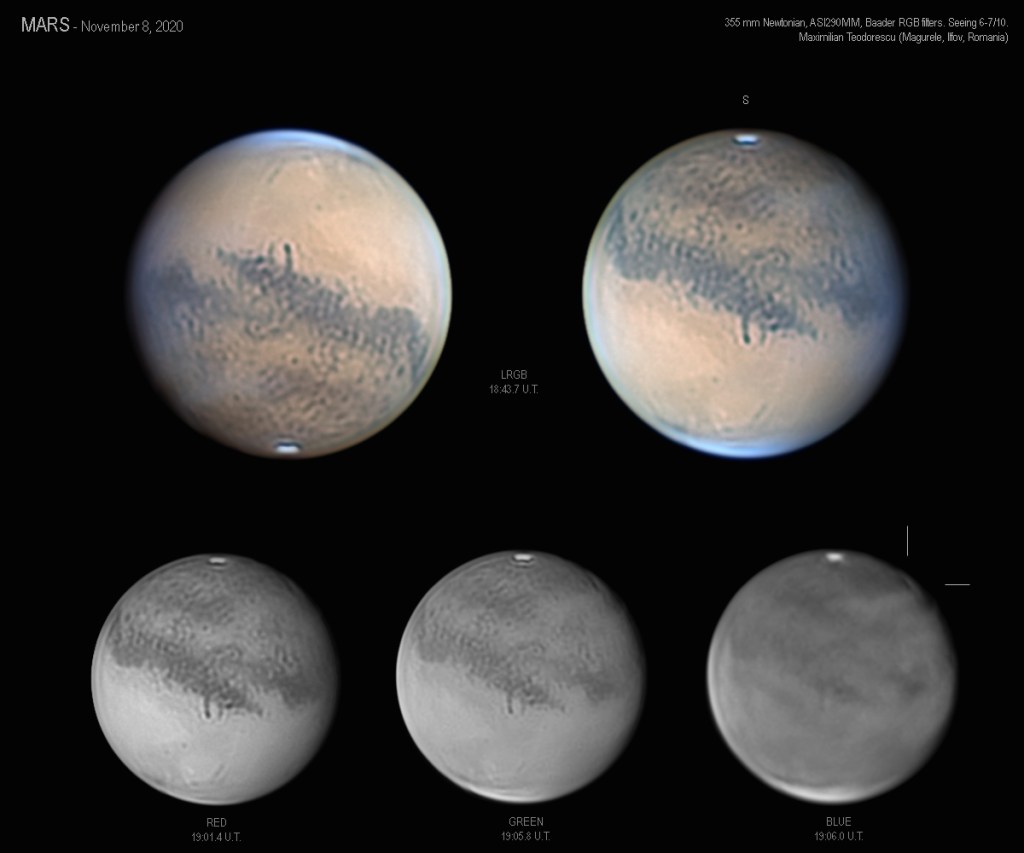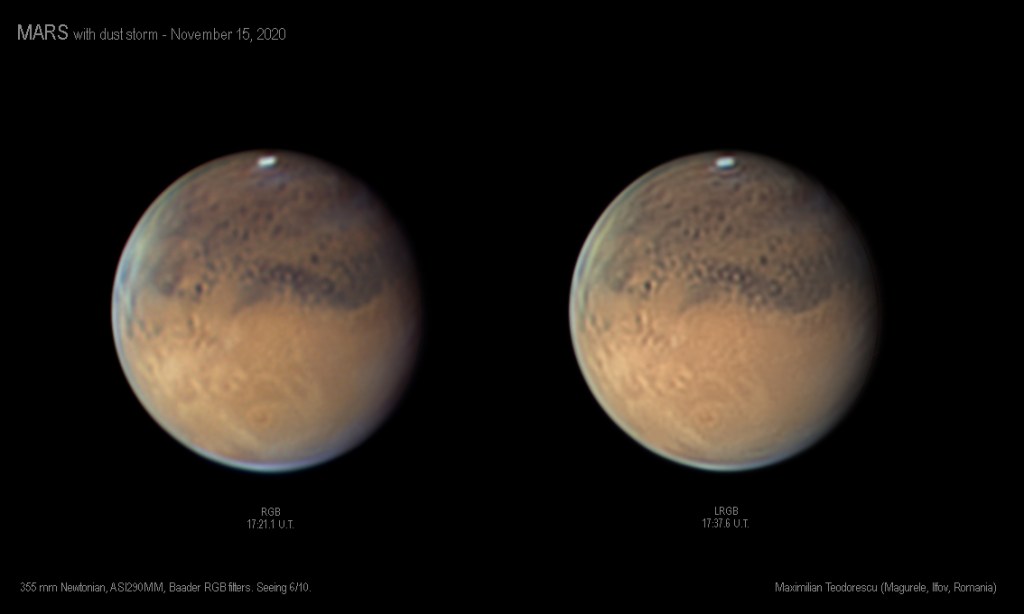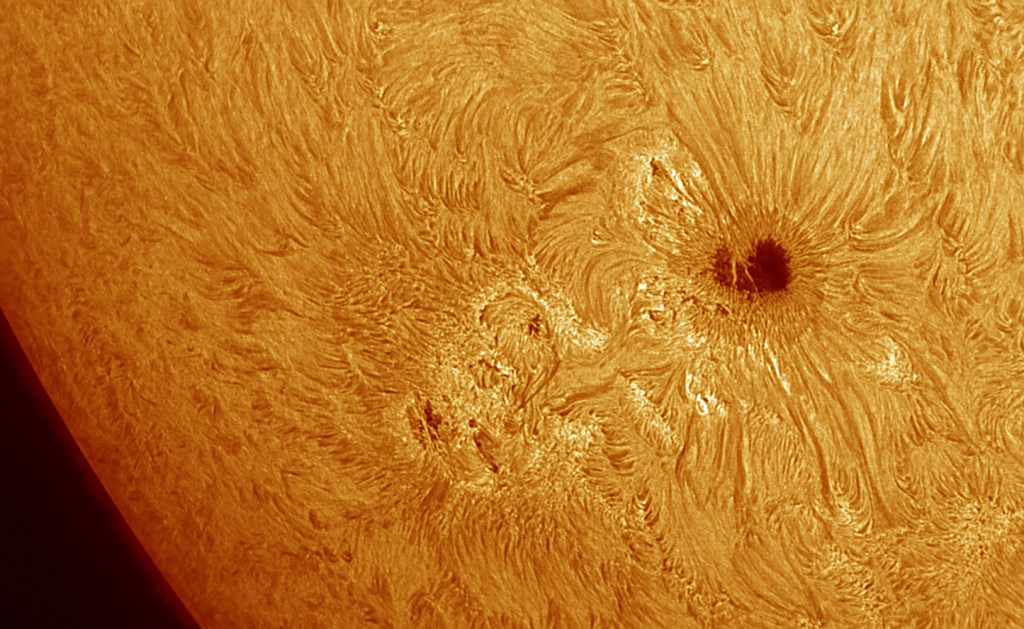1.
The following series was part of a test for the 228mm H-alpha refractor. Only the red part of the spectrum is usable (as it should) so only monochrome images have resulted. All three imaged planets were at around 20 to 23 degrees above the horizon, so pretty low for any serious images; still, some details are detectable, like the GRS, the Cassini division, the polar cap.
2.
While testing some filters (both H alpha and others), I’ve also acquired a few views of today’s solar features. A few spots, a few proms, and some other details observable in the chromosphere. All shot with the 150mm achromat and Quark filter.
And a prominance:
3. The planets with the 355mm Newtonian on August 3, 2020. Under moderate to good seeing. Mars is getting bigger 😉
An animation spanning almost half an hour:
The Sun in H-alpha on August 12, with a lot of details. Of importance is a complex-looking prominence, but also a new active region. 150mm refractor, Quark Chromosphere, ASI 174MM. Seeing 5-7/10.
Moon shots with the 355mm Newtonian in some good seeing on the morning of August 14, in red light:
A short 8 frame animation showing about 80 minutes of rotation on planet Mars. August 14, 355mm Newton, Red filter. Seeing 7-8/10. Poor transparency.
Mars in very good seeing, but only Red light, on August 14, 2020:
Saturn on August 13, in poor seeing:
Mars on August 18, in good seeing conditions:
A short RGB animation showing the rotation of Mars in one hour on August 18, 2020:
Mars on August 20, 2020, in mostly poor seeing. Syrtis Major feature is seen. Note the polar cap has shrinked a lot.
Jupiter with an outbreak, on August 21 2020:
And an animation spanning about 20 minutes showing the rotation of the planet and the outbreak:
Saturn on August 21, 2020:
Mars on August 21, 2020:
And an animation of Mars rotation, acquired in 2 hours and 45 minutes:
A selection of three de-rotated views of Mars from August 21-22, 2020:
The three planets of August 21, 2020, not to scale (Mars should be almost two times smaller):
A test for my new Baader Johnson U filter. Horrible conditions, Venus being only a blurred object on the laptop screen:
Mars with an orographic cloud in very good seeing:
A short animation showing 1.5 hours of Martian rotation on August 29:
Mars in fantastic seeing on September 1, 2020:
The RGB series from September 1, showing some clouds on the terminator in the blue filter image:
An animation from Sept 1 from the Red filter data:
An animation from Sept 1 from the Blue filter data:
An animation from Sept 1 from the Green filter data:
RGB all filters animation:
One more animation showing the IR channel for 1.5 hours:
The Moon on September 1:
Mars on September 4, 2020, in very poor seeing. Note the elongated cloud in the blue filter image, near Arsia Mons.
Mars on September 7. This is the first sequence of the session, when the seeing was not that good. Just moments later the seeing improved considerably. More data will be processed soon.
Another series from Sept 7:
And a two frame animation:
Some lunar imagery from September 8:
Mars on September 9, 2020, from high up in the mountains, near Piatra Arsa Peak. Some very good to excellent moments of seeing, but mostly fair to good.
A short animation showing 12 minutes of rotation”
Mars on September 12, 2020, in fair to good seeing:
Saturn on September 13, 2020:
An animation showing planet Jupiter rotating in half an hour. Note the chaos in the bands made by one of the currently three disturbances:
Jupiter images from September 13, 2020, showing the first NTB disturbance effects on the NEB. Poor seeing in the RGB data, so I had to mix it with the IR. The low altitude of the planet is not helping me much…
Planets of September:
Marsturn 😉
Mars on September 13, 2020, in fair seeing:
Mars animation showing the planet rotate in about 1.5 hours, on September 15, 2020. Red filter data acquired in very good seeing.
Mars RGB set from September 15, 2020:
RGB animation made up from four sequences:
And the sequence from the above animation:
Approaching MARS:
Jupiter on September 16, under poor seeing conditions:
Solar imagery from September 24, 2020. 150mm achromat, Quark H alpha filter, ASI174MM.
Mars on September 23, 2020 with a 150 mm achromat refractor (Bresser). Just my first light with the ASI290MM camera. It was a fun session 😉
Mars under fair seeing conditions on September 22, 2020. Note the clouds at the terminator in the B image.
Mars animation showing only the Red filter data, from September 24, 2020. It shows about 3 hours of rotation. Variable seeing, decreasing from 8/10 to 5-6/10. 355mm Newtonian, ASI290MM, Baader red filter. South up.
Mars from September 24, 2020:
Mars with a 4.5 inch Refractor…just for fun 😉
Some details are detectable, like Sinus Gomer. Shot with the 115mm TS APO refractor in 4-5/10 seeing conditions. The Blue filter image shows some surprising details for such a small instrument.
And a short animation:
Mars under poor seeing conditions on September 27, 2020. Only the IR 742 nm filter offered some details, so a strange (for me) image scheme had to be performed: the Luminance is formed from Red data and IR 742 data, while the Green is synthetic (it was very very poor). Sinus Gomer is seen setting on the terminator, Sinus Meridiani is coming into view. At the meridian, both Syrtis Major and Hellas dominate the view with crater Herschel defined.
One month of evolution of the martian South Polar Cap (SPC). I’m presenting both images of Mars at the same scale to better grasp the shrinking of the SPC.
All my Mars shots for the 2020 opposition onto one image, all at the same scale and transformed to grayscale to better view the changes in phase and SPC evolution:
Venus on October 2, 2020 in poor seeing. Some clouds are detectable.
Mars on October 2, 2020 in good seeing conditions.
Mare Crisium on October 3, 2020. Fair seeing only, but some fine details can be seen. 355mm Newtonian, ASI174MM. Red filter.
Lunar crater Dionysius (Diameter: 18 km). One of my favorite small craters, due to its sharp rim and the ejecta material all around it. Looks rather “fresh” 😉
355mm Newton, ASI174MM. Seeing 6/10. October 3, 2020.
Lunar crater Petavius on October 3, 2020. Fair to good seeing for this image. Some fine details are to be seen inside the crater. 355mm Newton, ASI174MM, Red filter.
Crater Cleomedes on October 3, 2020 in fair seeing. Note the fine rills inside the crater floor.
Crater Janssen under high Sun. Fair to poor seeing, so not much fine detail here.
Crater Langernus on October 3, 2020 in mostly poor seeing with a few moments of fair seeing.
Crater Pythagoras under very high Sun on October 3, 2020. Poor seeing for this shot but a nice view of the area.
Mars on October 3, 2020. 20 minutes of rotation in a few seconds. Sequences acquired in very good to excellent seeing. Lot of details like craters are observable on the planet. Note the South Polar Cap size at this longitude: it will be gone soon. Some clouds on the limb above Syrtis Major, and the North Polar clouds going strong. 355mm Newtonian, ASI290MM, Baader RGB filters. Seeing 7-8/10. North up image. This is definitely my best sequence for this opposition yet.
Mars RGB data from October 3, 2020:
A five image compilation showing the size evolution of Mars in one month as it approached Earth:
A few Moon images from October 11, 2020, acquired in very good seeing but with heavy dew on my optics…
This is my first run with the ASI290MM for this kind of images. Not a bad camera for the Moon either, but I still prefer the 174MM for lunar work.
355mm Newton, ASI290MM, Red filter.
Lunar crater Schiller from October 11, 2020. A very elongated crater, which may well bare the name “the whale crater” 😉
355mm Newton, ASI290MM, Red filter. Seeing7/10.
Mars on October 10, 2020. Lots of clouds in the Tharsis area near the terminator. Olympus Mons dominates the upper-right quadrant.
A Mars animation showing almost 90 minutes of rotation on October 11, 2020. Olympus Mons and the clouds above Tharsis are setting, while other clouds are seen appearing on the limb. 355mm Newtonian, ASI290MM, RGB filters.
Mars on October 10, 2020: LRGB images and Blue filter images. Note the clouds in the Blue images: a lot of activity compared to just a month ago.
Domes near lunar crater T. Mayer. A few domes are seen in the image, with the most interesting being a small gathering just South (below) of T. Mayer. 355mm Newton, ASI290MM, Red filter. October 11, 2020.
And a wider view including Copernicus:
Gassendi in fair to good seeing on October 11, 2020:
Hansteen and Billy craters area. A pair of similar sized craters, at around 45 kilometers in diameter. October 11, 2020. 355mm Newton, ASI290MM, Red filter.
Lunar craters Kepler (up) and Encke, of similar diameters: around 30 kilometers. October 11, 2020. 355mm Newton, ASI 290MM, Red filter. Seeing 7-8/10.
Some dark halo craters marked on the above image:
Lunar crater Aristarchus and Vallis Schroteri on October 11, 2020. Good seeing but a lot of dew on the mirrors. 355mm Newton, ASI290MM, Red filter.
Mars with Phobos on October 11, 2020.
I’ve combined two different images with very different settings (a 1000 out of 9000 frames stack with very short millisecond exposures for Mars, and 400 frames stack of 100 milliseconds exposures for the satellite), with very close acquisition time to show as close as possible the position of Phobos relative to the planet details at that moment. Deimos was far out the frame at the time. Olympus Mons is setting in the image. Phobos was near its maximum elongation from the planet.
Mars on Ocotber 14, 2020 in poor seeing. Some cloud activity might be discerned in the Blue filter image. Olympus Mons is seen. The upper right image was obtained from Red and and Enhanced Blue filter image, plus a synthetic Green (R+B).
Active Region 2776 on October 17, 2020.
A brief spell of clear skies and fair seeing allowed for a quick shot of this new active sunspot group. It belongs to the new Solar Cycle 25, and shows some nice activity in H alpha. The animation shows a transition from Photosphere to Chromosphere and back.
Images acquired using a 150mm Refractor, Herschel Prism for White light, Quark Chromosphere for H-alpha, ASI 174MM.
A gigantic prom on October 19, 2020. It looks like the Sun offers some very nice views in H alpha these days. 150mm refractor, Quark H alpha filter. ASI174MM. Seeing 5/10.
Mars on October 18, 2020.
Poor conditions for this session, yet Vallies Marineris is detectable, as is Olympus Mons near the limb. Some cloud activity all-around the planet.
Solar activity on October 19, 2020. Three medium to large prominences, and one active region imaged just after a small flare.
Mars on October 19, 2020. Good seeing in some moments for this session. Vallis Marineris is well seen at the northern edge of Solis Lacus.
A three frame animation showing Mars rotate in about 40 minutes, on October 19, 2020:
Mars on October 20, 2020. These are the poorest conditions I’ve ever experienced, I think. If Pickering Seeing Scale would have a 0 value, this would be it ;). Here are some frames from this magnificent session. 355mm Newton, ASI290MM, IR 742nm FILTER (!!!), gamma to around 80, at 120 fps, speed at 10 fps in the animation.
Mars on October 22, 2020 with a new dark feature, yet to be understood:
Some measurements of the dark streak imaged on October 22, 2020 on Mars.
First, using Winjupos, two maps were generated, and the streak’s length was measured at over 600 km. Interestingly, on the Mars Orbiter Map, there are no features that could be accounted for such a dark aspect. Position for 22:19 U.T.: Eastern end: L1=128.5 B=-10.6 , Western end: L1=137.4 B=-5.8.
Secondly, the dark streak looks that it shifts its position and also fades as it gets further away from the terminator. It actually looks like it is moving with the surrounding clouds (which are visible in the animation).
Mars on October 23, 2020 showing the dark streak again, but somewhat fainter. The seeing conditions were also only fair, with some poor moments also. The animation spans the interval between 22:44 and 23:24 U.T.
A significant change in aspect (orientation) is detectable compared to the October 22 image. The western end is now more towards the south compared to the previous observation.
355 mm Newton , ASI290MM, Red filter.
Aspect changes in one day of the dark streak on Mars. This is definitely not an surface feature, but most likely atmospheric:
Mars on October 23, 2020. This was acquired some time before the dark streak was visible. Interesting to note the cloud activity in much of the South-West (lower left) quadrant of the planet, best visible in the B filter image.
A comparison between the Oct 22 and Oct 23 images showing almost the same meridian: note the differences in cloud shapes/positions/intensity, and also of the North Polar hood. Luckily the seeing was almost the same in the two sessions.
All my “dark streak” images in one slide (up until Oct 23):
Mars on October 26, 2020. In variable seeing and highly variable transparency due to waves of fog. Note the NPH very strong at this CM.
The volcanic complex Mons Rümker and the large partial rim crater Sinus Iridum. Acquired on October 29, 2020 in good seeing but very poor transparency. 355mm Newton, ASI174MM, Red filter. Below is an detail from the above showing only Mons Rümker.
Mars on October 29, 2020. Fair seeing with some good moments, but all through some clouds and fog. Didn’t have patience to get a longer RGB series, so the result is not really good. However, some clouds are detected in the South-Western quadrant, especially towards the terminator.
The very long and complex Rimae Sirsalis. Imaged on Oct 29, 2020 with a 355 mm Newtonian and ASI290MM in red light. Seeing 6/10 and poor transparency due to fog.
Two of the most striking lunar formations: crater Aristarchus and Vallis Schroteri. October 29, 2020. 355mm Newtonian, ASI290MM, Red filter. Seeing 6/10. Fog.
The new Mare Crisium dome, imaged on November 1, 2020 with an 355 mm Newtonian, ASI290MM, IR 742nm filter. Poor seeing.
Part of Mare Crisium on November 1, 2020. Poor to very poor seeing for this session, so only the IR742nm filter showed some details. 355mm Newton, ASI290MM.
A short Mars animation acquired on November 1, 2020 in poor conditions. The images are a combination of Red data with IR 742 nm. The animation spans between 21:09 to 21:31 U.T.
Syrtis Major and Sinus Merdiani are well seen, as is the Hellas Basin and the South Polar Cap. Mars is around 20 arcsec now, and getting smaller every day…
355mm Newtonian, ASI290MM.
Mars data from November 1, 2020. Poor and very poor seeing.
Giant sunspot AR2781 on November 5, 2020. Images acquired with a 150 mm achromat, Quark H alpha filter and ASI174MM. Fair seeing. The Earth was inset for size comparison. A second image shows also a H-alpha view, but with the filter set a bit off-band. Lots of Ellerman bombs are detectable.
The dynamic sunspot AR2781 on November 5, 2020. About 50 minutes of evolution in just two seconds. Animation start at 10:52 U.T. Note the small flares that occur simultaneously (center and left).
Sunspot AR2781 on November 7, 2020. Poor seeing and lots of clouds covering the Sun, but I had to image this huge sunspot group! Still going strong today. 150mm Refractor, Quark H alpha filter, ASI174MM.
Sunspot AR2781 on November 8, 2020. Good seeing for this session, so I was able to also acquire some white light images.
A short 13 frame animations showing the activity inside sunspot group AR2781 on November 8, 2020. Note the in/out of the plasma along the magnetic lines all around the main sunspot at right. Also the many Ellerman bombs emerging around the spot.
150mm achromat, ASI174MM, Quark H alpha filter.
Planet Mars on November 8, 2020. Good seeing for this session. A high altitude cloud is visible on the terminator; it is marked in the Blue filter image, but it is visible in all three filters. Lots of have/clouds on the entire planet.
A reprocessing of the November 8 Mars session:
A short animation showing Mars on November 8, 2020. Red filter data only. 355mm Newton, ASI290MM. Seeing 6-7/10.
Mars on November 6, 2020 under poor conditions. I’ve used only the Red and Blue filter images, as Green was very poor…
Some of the best known craters on the Moon: Clavius, Copernicus and Plato.
Images acquired on October 26, 2020 in poor to fair seeing conditions with the 355mm Newtonian and ASI174MM with a red filter.
A Mars image showing part of the expanding dust storm. Good seeing for this session, but not the best meridian yet to properly see the dust storm.
One more RGB processing:
Mars on November 15, 2020: a three frame animation showing about 15 minutes of rotation. South up animation. The dust storm is east of Solis Lacus. Olympus Mons is seen toward North. The NPH is very thin at this meridian. Note the faint clouds towards the South Polar Cap.
New giant sunspot on November 23, 2020. 150 mm Refractor, Quark H alpha filter, ASI174MM. Fair seeing.
Mars on November 22, 2020. The dust storm looks almost global, with all areas of low contrast. The Tharsis volcanoes and their shadows are seen in the lower right near the terminator. Poor seeing with some fair moments. Only the Red and Blue data were acquired.
A short animation from Nov 23:
This is how our view of the Red Planet has changed in only one month: the size of the planet has decreased with about 6 arc seconds, the South Polar Cap has also decreased, and now there is a dust storm that has expanded on much of the planet resulting in a lower contrast or even totally obscured views of some features.
Both images are at the same scale. Solis Lacus has a lower contrast in the November 22 image due to dust, and a slightly different shape. Also some dust is seen in Valles Marineris. The three Tharsis volcanoes are also seen.
AR 2786 on November 24, 2020. A giant spot with some moderate activity in and around it (for now). H-alpha images in poor to fair seeing. 150mm achromat, ASI174MM, Quark H alpha filter.
Mars on November 24, 2020. The extent of the dust storm is apparent now, as most of the area East (left) of Solis Lacus is covered with dust. I have also included a strongly enhanced color processing for better contrast of the dust; basically everything that has a greenish tint is dust.
Poor seeing for this session, but it was just enough to view a major storm on another planet 😉
Crater Clavius on November 25, 2020. Poor to fair seeing. 355mm, 174MM.

AR 2786 on November 26, 2020 in fair seeing. 150 achromat, Quark H alpha.
AR 2786 on November 27, 2020. 150mm achromat, Quark H alpha filter:
Two sunspot groups on December 1, 2020. The upper one, named 2790 was responsible for a major solar flare on November 28, 2020. However it looks pretty small and shy now. The lower group, AR 2786 has already started to decay. 150mm achromat, Quark H alpha filter, ASI174MM. Very poor and poor seeing.




